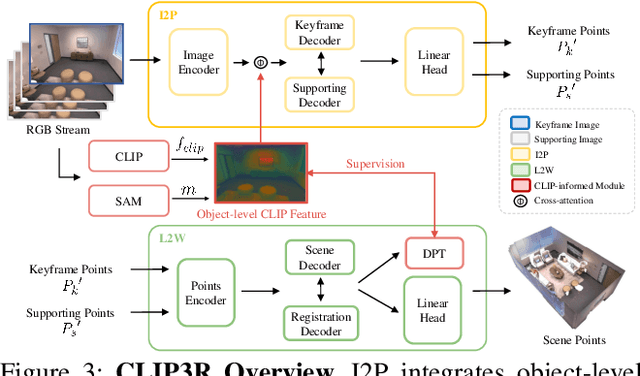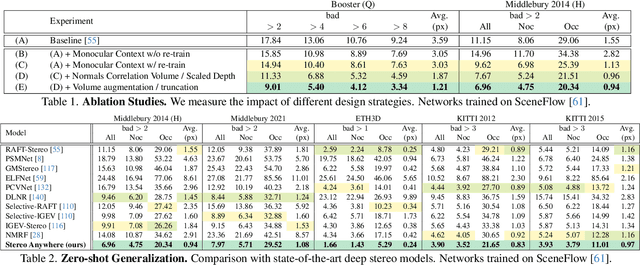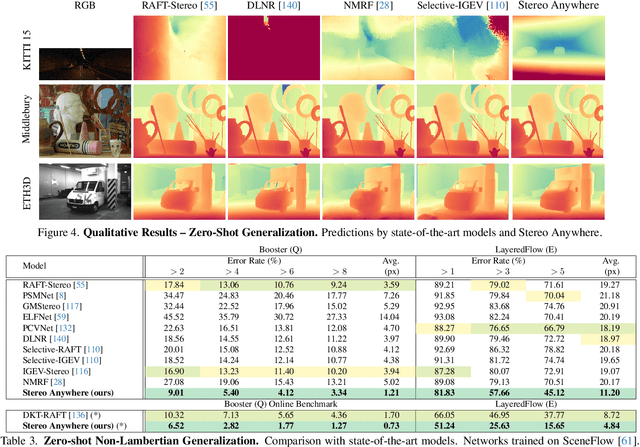Fabio Tosi
Depth AnyEvent: A Cross-Modal Distillation Paradigm for Event-Based Monocular Depth Estimation
Sep 18, 2025Abstract:Event cameras capture sparse, high-temporal-resolution visual information, making them particularly suitable for challenging environments with high-speed motion and strongly varying lighting conditions. However, the lack of large datasets with dense ground-truth depth annotations hinders learning-based monocular depth estimation from event data. To address this limitation, we propose a cross-modal distillation paradigm to generate dense proxy labels leveraging a Vision Foundation Model (VFM). Our strategy requires an event stream spatially aligned with RGB frames, a simple setup even available off-the-shelf, and exploits the robustness of large-scale VFMs. Additionally, we propose to adapt VFMs, either a vanilla one like Depth Anything v2 (DAv2), or deriving from it a novel recurrent architecture to infer depth from monocular event cameras. We evaluate our approach with synthetic and real-world datasets, demonstrating that i) our cross-modal paradigm achieves competitive performance compared to fully supervised methods without requiring expensive depth annotations, and ii) our VFM-based models achieve state-of-the-art performance.
FlowSeek: Optical Flow Made Easier with Depth Foundation Models and Motion Bases
Sep 05, 2025Abstract:We present FlowSeek, a novel framework for optical flow requiring minimal hardware resources for training. FlowSeek marries the latest advances on the design space of optical flow networks with cutting-edge single-image depth foundation models and classical low-dimensional motion parametrization, implementing a compact, yet accurate architecture. FlowSeek is trained on a single consumer-grade GPU, a hardware budget about 8x lower compared to most recent methods, and still achieves superior cross-dataset generalization on Sintel Final and KITTI, with a relative improvement of 10 and 15% over the previous state-of-the-art SEA-RAFT, as well as on Spring and LayeredFlow datasets.
Stereo 3D Gaussian Splatting SLAM for Outdoor Urban Scenes
Jul 31, 2025Abstract:3D Gaussian Splatting (3DGS) has recently gained popularity in SLAM applications due to its fast rendering and high-fidelity representation. However, existing 3DGS-SLAM systems have predominantly focused on indoor environments and relied on active depth sensors, leaving a gap for large-scale outdoor applications. We present BGS-SLAM, the first binocular 3D Gaussian Splatting SLAM system designed for outdoor scenarios. Our approach uses only RGB stereo pairs without requiring LiDAR or active sensors. BGS-SLAM leverages depth estimates from pre-trained deep stereo networks to guide 3D Gaussian optimization with a multi-loss strategy enhancing both geometric consistency and visual quality. Experiments on multiple datasets demonstrate that BGS-SLAM achieves superior tracking accuracy and mapping performance compared to other 3DGS-based solutions in complex outdoor environments.
Ov3R: Open-Vocabulary Semantic 3D Reconstruction from RGB Videos
Jul 29, 2025



Abstract:We present Ov3R, a novel framework for open-vocabulary semantic 3D reconstruction from RGB video streams, designed to advance Spatial AI. The system features two key components: CLIP3R, a CLIP-informed 3D reconstruction module that predicts dense point maps from overlapping clips while embedding object-level semantics; and 2D-3D OVS, a 2D-3D open-vocabulary semantic module that lifts 2D features into 3D by learning fused descriptors integrating spatial, geometric, and semantic cues. Unlike prior methods, Ov3R incorporates CLIP semantics directly into the reconstruction process, enabling globally consistent geometry and fine-grained semantic alignment. Our framework achieves state-of-the-art performance in both dense 3D reconstruction and open-vocabulary 3D segmentation, marking a step forward toward real-time, semantics-aware Spatial AI.
NTIRE 2025 Challenge on HR Depth from Images of Specular and Transparent Surfaces
Jun 06, 2025Abstract:This paper reports on the NTIRE 2025 challenge on HR Depth From images of Specular and Transparent surfaces, held in conjunction with the New Trends in Image Restoration and Enhancement (NTIRE) workshop at CVPR 2025. This challenge aims to advance the research on depth estimation, specifically to address two of the main open issues in the field: high-resolution and non-Lambertian surfaces. The challenge proposes two tracks on stereo and single-image depth estimation, attracting about 177 registered participants. In the final testing stage, 4 and 4 participating teams submitted their models and fact sheets for the two tracks.
The Fourth Monocular Depth Estimation Challenge
Apr 24, 2025Abstract:This paper presents the results of the fourth edition of the Monocular Depth Estimation Challenge (MDEC), which focuses on zero-shot generalization to the SYNS-Patches benchmark, a dataset featuring challenging environments in both natural and indoor settings. In this edition, we revised the evaluation protocol to use least-squares alignment with two degrees of freedom to support disparity and affine-invariant predictions. We also revised the baselines and included popular off-the-shelf methods: Depth Anything v2 and Marigold. The challenge received a total of 24 submissions that outperformed the baselines on the test set; 10 of these included a report describing their approach, with most leading methods relying on affine-invariant predictions. The challenge winners improved the 3D F-Score over the previous edition's best result, raising it from 22.58% to 23.05%.
HS-SLAM: Hybrid Representation with Structural Supervision for Improved Dense SLAM
Mar 27, 2025Abstract:NeRF-based SLAM has recently achieved promising results in tracking and reconstruction. However, existing methods face challenges in providing sufficient scene representation, capturing structural information, and maintaining global consistency in scenes emerging significant movement or being forgotten. To this end, we present HS-SLAM to tackle these problems. To enhance scene representation capacity, we propose a hybrid encoding network that combines the complementary strengths of hash-grid, tri-planes, and one-blob, improving the completeness and smoothness of reconstruction. Additionally, we introduce structural supervision by sampling patches of non-local pixels rather than individual rays to better capture the scene structure. To ensure global consistency, we implement an active global bundle adjustment (BA) to eliminate camera drifts and mitigate accumulative errors. Experimental results demonstrate that HS-SLAM outperforms the baselines in tracking and reconstruction accuracy while maintaining the efficiency required for robotics.
Stereo Anywhere: Robust Zero-Shot Deep Stereo Matching Even Where Either Stereo or Mono Fail
Dec 05, 2024



Abstract:We introduce Stereo Anywhere, a novel stereo-matching framework that combines geometric constraints with robust priors from monocular depth Vision Foundation Models (VFMs). By elegantly coupling these complementary worlds through a dual-branch architecture, we seamlessly integrate stereo matching with learned contextual cues. Following this design, our framework introduces novel cost volume fusion mechanisms that effectively handle critical challenges such as textureless regions, occlusions, and non-Lambertian surfaces. Through our novel optical illusion dataset, MonoTrap, and extensive evaluation across multiple benchmarks, we demonstrate that our synthetic-only trained model achieves state-of-the-art results in zero-shot generalization, significantly outperforming existing solutions while showing remarkable robustness to challenging cases such as mirrors and transparencies.
Self-Evolving Depth-Supervised 3D Gaussian Splatting from Rendered Stereo Pairs
Sep 11, 2024



Abstract:3D Gaussian Splatting (GS) significantly struggles to accurately represent the underlying 3D scene geometry, resulting in inaccuracies and floating artifacts when rendering depth maps. In this paper, we address this limitation, undertaking a comprehensive analysis of the integration of depth priors throughout the optimization process of Gaussian primitives, and present a novel strategy for this purpose. This latter dynamically exploits depth cues from a readily available stereo network, processing virtual stereo pairs rendered by the GS model itself during training and achieving consistent self-improvement of the scene representation. Experimental results on three popular datasets, breaking ground as the first to assess depth accuracy for these models, validate our findings.
Diffusion Models for Monocular Depth Estimation: Overcoming Challenging Conditions
Jul 23, 2024Abstract:We present a novel approach designed to address the complexities posed by challenging, out-of-distribution data in the single-image depth estimation task. Starting with images that facilitate depth prediction due to the absence of unfavorable factors, we systematically generate new, user-defined scenes with a comprehensive set of challenges and associated depth information. This is achieved by leveraging cutting-edge text-to-image diffusion models with depth-aware control, known for synthesizing high-quality image content from textual prompts while preserving the coherence of 3D structure between generated and source imagery. Subsequent fine-tuning of any monocular depth network is carried out through a self-distillation protocol that takes into account images generated using our strategy and its own depth predictions on simple, unchallenging scenes. Experiments on benchmarks tailored for our purposes demonstrate the effectiveness and versatility of our proposal.
 Add to Chrome
Add to Chrome Add to Firefox
Add to Firefox Add to Edge
Add to Edge